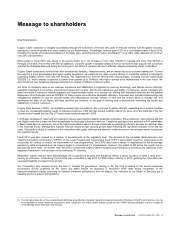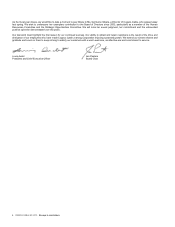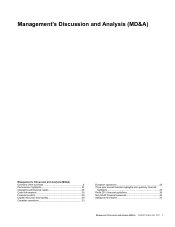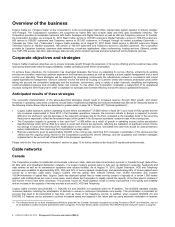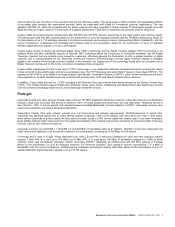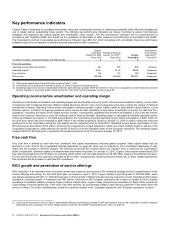Cogeco 2010 Annual Report Download - page 16
Download and view the complete annual report
Please find page 16 of the 2010 Cogeco annual report below. You can navigate through the pages in the report by either clicking on the pages listed below, or by using the keyword search tool below to find specific information within the annual report.Management’s Discussion and Analysis (MD&A) COGECO CABLE INC. 2010 15
Section 3863 establishes standards for presentation of financial instruments and non-financial derivatives. It deals with the classification of
financial instruments, from the perspective of the issuer, between liabilities and equities, the classification of related interest, dividends, gains
and losses, and circumstances in which financial assets and financial liabilities are offset.
The adoption of these standards did not have any impact on the classification and measurements of the Corporation’s financial instruments.
The new disclosures pursuant to these new sections are included in note 18 of the Corporation’s consolidated financial statements.
General standards of financial statement presentation
The CICA amended Section 1400 of the CICA Handbook, General standards of financial statement presentation, to include a requirement for
management to make an assessment of the entity’s ability to continue as a going concern when preparing financial statements. These
changes, including the related disclosure requirements, were adopted by the Corporation on September 1, 2008 and had no impact on the
consolidated financial statements.
Credit risk and fair value of financial assets and financial liabilities
On January 20, 2009, the Emerging Issues Committee (“EIC”) of the Canadian AcSB issued EIC Abstract 173, Credit risk and fair value of
financial assets and financial liabilities, which establishes guidance requiring an entity to consider its own credit risk as well as the credit risk of
the counterparty in determining the fair value of financial assets and financial liabilities, including derivative instruments. EIC-173 is applicable
to all financial assets and liabilities measured at fair value in interim and annual financial statements for periods ending on or after
January 20, 2009 and was applicable to the Corporation for its second quarter of fiscal 2009 with retrospective application to the beginning of
the 2009 fiscal year, without restatement of prior periods. The adoption of this new abstract during the second quarter of 2009 had no
significant impact on the consolidated balance sheet at September 1, 2008.
Future accounting pronouncements
Harmonization of Canadian and International accounting standards
In March 2006, the AcSB of the CICA released its new strategic plan, which proposed to abandon Canadian GAAP and effect a complete
convergence to the International Financial Reporting Standards (“IFRS”) for Canadian publicly accountable entities. This plan was confirmed in
subsequent exposure drafts issued in April 2008, March 2009 and October 2009. The changeover will occur no later than fiscal years beginning
on or after January 1, 2011. Accordingly, the Corporation’s first interim consolidated financial statements presented in accordance with IFRS
will be for the quarter ending November 30, 2011, and its first annual consolidated financial statements presented in accordance with IFRS will
be for the year ending August 31, 2012.
IFRS uses a conceptual framework similar to Canadian GAAP, but there are significant differences in recognition, measurement and disclosure
requirements. The Corporation has established a project team including representatives from various areas of the organization to plan and
complete the transition to IFRS. This team reports periodically to the Audit Committee, which oversees the IFRS implementation project on
behalf of the Board of Directors. The Corporation is assisted by external advisors as required.


